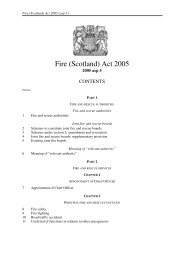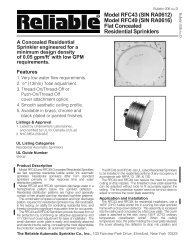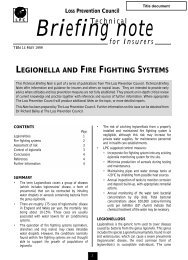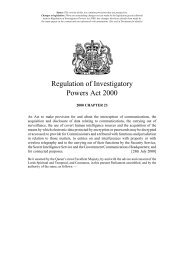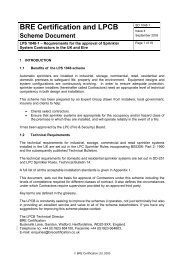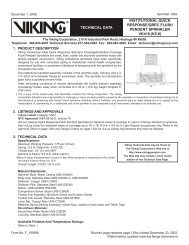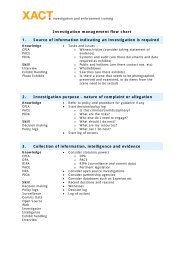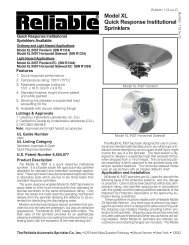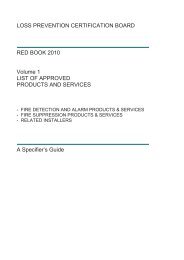The Nature, Extent and Economic Impact of ... - Cardiff University
The Nature, Extent and Economic Impact of ... - Cardiff University
The Nature, Extent and Economic Impact of ... - Cardiff University
Create successful ePaper yourself
Turn your PDF publications into a flip-book with our unique Google optimized e-Paper software.
<strong>The</strong> <strong>Nature</strong>, <strong>Extent</strong> <strong>and</strong> <strong>Economic</strong> <strong>Impact</strong> <strong>of</strong> Fraud in the UK<br />
Annex 7 provides a table that summarises these various costs <strong>and</strong> which suggests the aggregate costs <strong>of</strong><br />
fraud are currently, at a minimum, <strong>of</strong> the order <strong>of</strong> £13 billion, excluding the costs <strong>of</strong> responding to fraud<br />
<strong>and</strong> any externalities.<br />
<strong>The</strong>re are however very considerable problems associated with aggregating these figures to provide an<br />
overall estimate <strong>of</strong> ‘fraud in the UK’. Some could, for example, dispute the criteria applied to include or<br />
exclude studies from the current review. 60 Added to this, the existing sources <strong>of</strong> data on fraud are neither<br />
mutually exclusive nor collectively exhaustive. <strong>The</strong> commentary in this report has frequently highlighted<br />
the problem <strong>of</strong> double-counting. To give an example, although APACS <strong>and</strong> CIFAS data are good, they very<br />
likely partly overlap. Equally, many <strong>of</strong> the cheque <strong>and</strong> payment card frauds mentioned by members <strong>of</strong> the<br />
public in surveys may already be accounted for in the data captured by the above bodies, whose<br />
members largely compensate them for their economic costs. Added to this, the existing sources <strong>of</strong> data<br />
on fraud can be shown to suffer from a range <strong>of</strong> different shortcomings (some <strong>of</strong> which are listed in the<br />
next section), so that quite legitimate differences on opinion can exist about the validity <strong>of</strong> any particular<br />
conclusion drawn. <strong>The</strong> recent highly-publicised differences between the Treasury, opposition parties <strong>and</strong><br />
BBC investigators over the extent <strong>of</strong> MTIC fraud <strong>of</strong>fers a telling example, as does the disagreement over<br />
the cost <strong>of</strong> spirits fraud.<br />
It also needs to be pointed out that just because specific types <strong>of</strong> fraud have not been subject to<br />
measurement, this does not mean they don’t exist. One unintended effect <strong>of</strong> the present ‘free market in<br />
information <strong>of</strong> fraud’ may be to emphasise cognitively those types <strong>of</strong> fraud (like payment card fraud) that<br />
are relatively well analysed, <strong>and</strong> are committed against articulate ‘repeat victims’, as against the more<br />
diffuse <strong>and</strong> less well-analysed or predictable frauds affecting other parts <strong>of</strong> the business community, the<br />
public sector or individuals.<br />
Moreover where fraud figures are available, they tend to focus primarily on the direct (transfer cost) <strong>of</strong><br />
fraud: the table in Annex 7 provides a breakdown <strong>of</strong> the known losses ‘by type’ <strong>and</strong> the direct costs<br />
comprise 93% <strong>of</strong> the total. It was pointed out at the beginning <strong>of</strong> this report that very few published<br />
sources provided information relating to the costs <strong>of</strong> fraud prevention <strong>and</strong>/or in response to fraud. No<br />
data are published in the proportion <strong>of</strong> compliance <strong>and</strong> regulation costs attributable to dealing with fraud<br />
as contrasted with other crimes or prudential issues. In this sense, again, the figures clearly understate the<br />
true cost, <strong>and</strong> probably by a substantial margin.<br />
Weaknesses relating to the current data on fraud<br />
In broad terms, the studies that have been reviewed have paid scant regard to adopting rigorous research<br />
methods; they have paid insufficient attention to the problematic interpretation <strong>of</strong> the term ‘fraud’ <strong>and</strong>—to<br />
the extent that fraud is a crime targeted on organisations as much as individuals—the survey exercises<br />
carried out share many <strong>of</strong> the problems associated with corporate surveys (e.g. the CVS) rather than with<br />
the better tested surveys <strong>of</strong> individuals <strong>and</strong>/or households (e.g. the BCS). Weaknesses in current fraud<br />
data can be grouped together around several key issues:<br />
Defining ‘fraud’. Questions about fraud <strong>of</strong>ten lack specificity. This does not matter greatly in the simpler<br />
forms <strong>of</strong> fraud, whether against individuals, businesses or public sector. If individuals pay direct for goods<br />
from someone they have encountered on e-Bay, by-passing normal controls, <strong>and</strong> the goods never arrive<br />
<strong>and</strong> the vendor cannot be found, then this clearly is fraud; likewise the data collected by APACS on<br />
60<br />
Different decisions could have dramatic consequences on the aggregate total quoted here. One survey <strong>of</strong> ‘economic crime’<br />
suffered by major corporations, for example, estimated that businesses lost fully £32 bn. in 2003. It cannot be ruled out<br />
that this estimate was <strong>of</strong> the correct order <strong>of</strong> magnitude. However, ‘economic crime’ is a far broader construct than ‘fraud’.<br />
This particular survey was deemed to have been based on a small postal survey covering an ambiguous period <strong>of</strong> time; it<br />
was heavily biased towards major companies which may not have separated out their losses in the UK from those suffered<br />
elsewhere; <strong>and</strong> the extrapolation methods used to derive aggregate estimates were not explained.<br />
39



